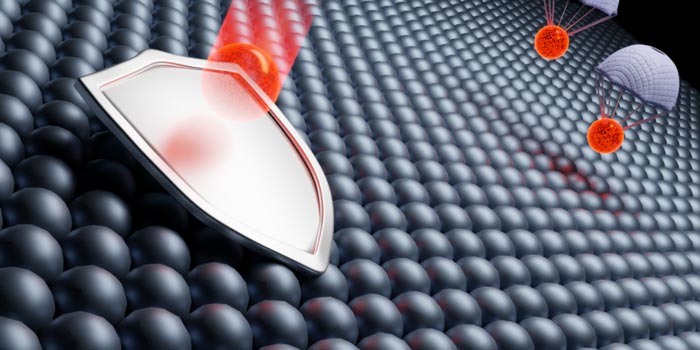Transparent electrodes without the damage

A review led by KAUST researchers sheds light on the strengths and weaknesses of different buffer materials used in optoelectronic devices.
Credit: © 2021 KAUST; Hassan Tahini
Crucial in the design of any semiconductor device is how to inject and extract an electrical current, and now a KAUST-led team has reviewed ways to do this without damage to the device.
A basic metal-semiconductor interface can create a potential energy barrier to the efficient flow of electrons, depending on the electronic properties of the two materials. It is vital to make a careful choice of contact material and the process by which this material is deposited onto the semiconductor. These design considerations are more complicated for optoelectronic components such as light-emitting diodes (LEDs), photodetectors and solar cells because these devices require a transparent contact material to allow light in or out.
Erkan Aydin and Stefaan De Wolf from the KAUST Solar Center, along with co-authors from Turkey, the Netherlands and Spain, have presented an overview for the process to stop damage occurring on devices during the creation of transparent electrodes, particularly for a technique known as sputtering.
Sputtering works by placing the target semiconductor into a vacuum chamber and surrounding it in a plasma. When an electric field is created between the target and the cathode made of the material to be sputtered, the fast-moving plasma ions transfer atoms/molecules from one to the other.
This technique is particularly useful for creating low resistivity and high transparency thin films of transparent conductive oxides (TCO), such as indium tin oxide (ITO).
However, the high kinetic energy of the ions can damage the semiconductor target. This degradation is severe enough to be seen using optical and electron microscopes, and leads to, for example, poorer device operation, lower maximum power output in solar cells and higher leakage current in LEDs.
“This is a common problem for many optoelectronic devices, but there is no universalized solution to mitigate it,” says Aydin.
Aydin and colleagues reviewed strategies for mitigating this damage, in particular using a buffer layer between the semiconductor and the electrode. “As a rule of thumb, buffer layers should be able to tolerate the particle damage during the sputtering process, while also functioning electronically and being optically transparent,” explains Aydin.
The co-authors summarize the strengths and weaknesses of different buffer materials and their suitability for different optoelectronic applications. They also compare numerous techniques for creating the buffer and give an overview for developing damage-free deposition of TCOs on optoelectronic devices in future.
“With this comprehensive review, we elaborate the problem from multiple aspects and give the readers a basic understanding of the issue and offer some cross-disciplinary learnings,” says Aydin.
Journal: Matter
DOI: https://doi.org/10.1016/j.matt.2021.09.021
Article Title: Sputtered transparent electrodes for optoelectronic devices: Induced damage and mitigation strategies
Article Publication Date: 3-Nov-2021
All latest news from the category: Power and Electrical Engineering
This topic covers issues related to energy generation, conversion, transportation and consumption and how the industry is addressing the challenge of energy efficiency in general.
innovations-report provides in-depth and informative reports and articles on subjects ranging from wind energy, fuel cell technology, solar energy, geothermal energy, petroleum, gas, nuclear engineering, alternative energy and energy efficiency to fusion, hydrogen and superconductor technologies.
Newest articles

NASA: Mystery of life’s handedness deepens
The mystery of why life uses molecules with specific orientations has deepened with a NASA-funded discovery that RNA — a key molecule thought to have potentially held the instructions for…

What are the effects of historic lithium mining on water quality?
Study reveals low levels of common contaminants but high levels of other elements in waters associated with an abandoned lithium mine. Lithium ore and mining waste from a historic lithium…

Quantum-inspired design boosts efficiency of heat-to-electricity conversion
Rice engineers take unconventional route to improving thermophotovoltaic systems. Researchers at Rice University have found a new way to improve a key element of thermophotovoltaic (TPV) systems, which convert heat…



